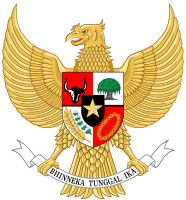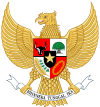Second Sjahrir Cabinet
Second Sjahrir Cabinet Kabinet Sjahrir II | |
|---|---|
3rd Cabinet of Indonesia | |
| 1946 | |
 | |
| Date formed | 12 March 1946 |
| Date dissolved | 2 October 1946 |
| People and organisations | |
| Head of state | Sukarno |
| Head of government | Sutan Sjahrir |
| No. of ministers | 24 ministers |
| History | |
| Predecessor | Sjahrir I Cabinet |
| Successor | Sjahrir III Cabinet |
| ||
|---|---|---|
|
Pre-independence Domestic policy Foreign policy Family Media and legacy Gallery: Picture, Sound, Video |
||
The Second Sjahrir Cabinet (Indonesian: Kabinet Sjahrir II) was the third Indonesian cabinet and the second formed by Sutan Sjahrir. It served from March to October 1946.
Background
The first Sjahrir cabinet had been forced to resign by Tan Malaka and his opposition Struggle Front. President Sukarno then offered this group the chance to form a new government, but it was unable to do so principally because of fears from other members of the group that Tan Malaka would try to replace Sukarno. Sukarno, with the support of the Central Indonesian National Committee (KNIP), then asked Sjahrir to form a new cabinet. The KNIP asked Sjahrir to form a cabinet including a wider range of opinion. Sjahrir agreed on the condition he would have the greater say in the choice of members. [1]
Composition
Ten of the members of the previous cabinet served in the new cabinet. It contained members from a range of political parties, but Sjahrir's group was still dominant.[2]
| Portfolio | Minister | Took office | Left office | Party | |
|---|---|---|---|---|---|
| Prime Minister Minister of Foreign Affairs Minister of Defense | 12 March 1946 | 2 October 1946 | PSI | ||
| Minister of Home Affairs | Soedarsono | 12 March 1946 | 2 October 1946 | PSI | |
| Minister of Justice | Soewandi | 12 March 1946 | 22 June 1946 | Independent | |
| Minister of Finance | Soerachman Tjokroadisuryo | 12 March 1946 | 2 October 1946 | Independent | |
| Minister of Agriculture and Supplies | Rasad | 12 March 1946 | 26 June 1946 | Independent | |
| Minister of Trade and Industry | 12 March 1946 | 26 June 1946 | Independent | ||
| Minister of Welfare | Darmawan Mangunkusumo | 26 June 1946 | 2 October 1946 | Independent | |
| Minister of Public Works | 12 March 1946 | 2 October 1946 | Parkindo | ||
| Minister of Transportation | Abdoel Karim | 12 March 1946 | 2 October 1946 | Independent | |
| Minister of Information | 12 March 1946 | 2 October 1946 | Masyumi | ||
| Minister of Social Affairs | Maria Ulfa Santoso (Perwari/PPI) | 12 March 1946 | 2 October 1946 | Independent | |
| Minister of Health | Dr. Darma Setiawan | 12 March 1946 | 2 October 1946 | Independent | |
| Minister of Education | Muhammad Sjafei | 12 March 1946 | 2 October 1946 | Independent | |
| Minister of Religious Affairs | 12 March 1946 | 2 October 1946 | Masyumi | ||
| State Minister | 12 March 1946 | 2 October 1946 | Independent | ||
| Junior Minister of Foreign Affairs | 12 March 1946 | 2 October 1946 | Independent | ||
| Junior Minister of Defense | 12 March 1946 | 2 October 1946 | Masyumi | ||
| Junior Minister of Justice | Hadi | 12 March 1946 | 2 October 1946 | Independent | |
| Junior Minister of Finance | 12 March 1946 | 2 October 1946 | Masyumi | ||
| Junior Minister of Agriculture and Supplies | Saksono | 12 March 1946 | 2 October 1946 | PSI | |
| Junior Minister of Communications | 12 March 1946 | 2 October 1946 | Independent | ||
| Junior Minister of Public Works | 12 March 1946 | 2 October 1946 | PNI | ||
| Junior Minister of Social Affairs | Abdul Madjid Djojoadiningrat | 12 March 1946 | 2 October 1946 | PSI | |
| Junior Minister of Health | 12 March 1946 | 2 October 1946 | Parkindo | ||
| Junior Minister of Education | Todung Sutan Gunung Mulia | 12 March 1946 | 2 October 1946 | Parkindo | |
Changes
Minister of Justice Soewandi resigned on 22 June 1946 and four days later Minister of Agriculture and Supplies Rasad lost his job when the ministry he headed was merged into the Ministry of Trade and Industry, which later became the Ministry of Welfare. Darmawan Mangoenkoesoemo was appointed Minister of Welfare and Saksono as Junior Minister of Welfare.[3]
The end of the cabinet
The second Sjahrir cabinet fell because of the kidnapping of Sjahrir and Darmawan Mangoenkoesoemo on 27 June 1946 by soldiers commanded by General Sudarsono. Like other opposition forces, they believed the government had betrayed the ideal of total independence by negotiating with the Dutch and conceding de facto Dutch control over parts of Indonesia. The rest of the cabinet held a meeting chaired by Amir Sjarifuddin and proposed transferring all powers to Sukarno. The president took control of the government by a decree issued on 28 June. This decree returned Indonesia to a presidential system and dissolved the cabinet.[4][5][6]
References
- Kahin, George McTurnan (1952) Nationalism and Revolution in Indonesia Cornell University Press, ISBN 0-8014-9108-8
- Ricklefs (1982), A History of Modern Indonesia, Macmillan Southeast Asian reprint, ISBN 0-333-24380-3
- Simanjuntak, P. N. H. (2003), Kabinet-Kabinet Republik Indonesia: Dari Awal Kemerdekaan Sampai Reformasi (in Indonesian), Jakarta: Djambatan, pp. 29–41, ISBN 979-428-499-8.


